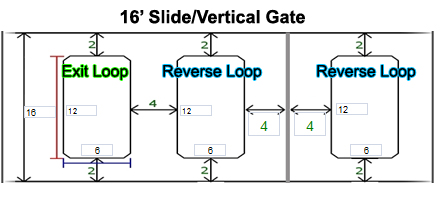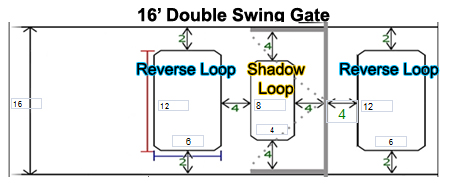Educational Articles
Loops: How to Insure Proper Placement and Size
Mrs. Jones was heading off to work in her brand-new luxury vehicle. She clicks the remote for her swing gate and it dutifully opens. As she begins to clear the driveway, she remembers that she forgot her briefcase that she needs for an important meeting. Mrs. Jones puts her car in park and jumps out to retrieve the briefcase from the kitchen. On her way toward the house, she hears a loud crunching sounds – her new car is being crushed by her slide gate!
Mrs. Jones was obviously upset. How could this have been prevented? Other than remembering her briefcase in the first place, loops could have been installed to detect that her car was in the gate path. Loops are the safest method of detecting vehicles in the gate path as they are not affected by weather or obstructions the way photo eyes can be. What dealers and installer must understand is how many loops need to be placed in the different gate systems and where. To better understand this, we will look at three types of common gate systems: slide gates, swing gates, and double swing gates.
How Many Loops and What Size Should I Use?

Slide gates require two reverse loops, one on each side of the gate — two feet from each curb and four feet away from the gate — to completely cover the gate path. You can come as close as two feet from the gate if the loops are properly phased. By using the proper layout and knowing the driveway width, you can determine the size of the loops needed. The two dimensions you need to find are the short and long leg of the loop. To find the long leg of the loop (z), subtract the driveway width (x) by four feet, represented by this formula: x – 4 = z. The short leg is determined by which types of vehicles are going through the gate. This is important because the short leg of the loops determines the detection height. If residential vehicles (low to the ground) are the only vehicles passing through, four feet is recommended. If commercial vehicles (UPS trucks for example) will be passing through, higher detection is required and 6 feet is recommended. An exit loop in this gate system is optional and follows the same formulas as the reverse loops. Exit loops can be located up to 1,000 feet from the gate. The advantage of a longer lead-in on the exit loop is to minimize the wait time for the gate to open

Swing gates require a total of three loops: two reverse loops on each side of the gate and a shadow loop. Reverse loops being installed on a swing gate need to be placed on each side of the gate, two feet from each curb and four feet away from the gate in its open position. Finding their size follows the same formula as slide gates: x – 4 = z. What is different in this gate system is the addition of a shadow loop. This loop is placed under the opening path of the gate, two feet away from the curb and four feet away from the gate in its closed position and four feet away from the gate in its open position. To determine the leg of the loop that is parallel to the gate in its closed position (y) subtract the driveway width (x) by 6 feet, represented by this formula: x – 6 = y. To find the leg of the loop that is parallel to the curb (a) subtract the driveway width (x) by four feet, represented by this formula: x – 4 = a. An exit loop in this gate system is optional and can be the reverse loops on the inside of the property (which will require a separate detector) or another loop can positioned a minimum of four feet away from reverse loop on the inside of the property.

Double swing gates require a total of three loops: two reverse loops on each side of the gate and a shadow loop. The reverse loops follow the same method of installation as swing gates; two feet from each curb and four feet away from the gate in its open position. Finding their size follows the same formula as slide gates and swing gates (x – 4 = z). To find the shadow loop leg that is parallel to the gate in its closed position (b), you need to subtract the driveway width (x) by eight; represented by this formula: x – 8 = b. To find the shadow loop leg that is parallel to the gate in its open position (c), you need to divide the driveway width (x) by two, then subtract that amount by four feet represented by this formula: (x / 2) – 4 = c. An exit loop in this gate system is optional and can be the reverse loops on the inside of the property (which will require a separate detector) or another loop can positioned a minimum of four feet away from reverse loop on the inside of the property.
Whenever possible the installation of direct burial loops should be used instead of saw-cuts. The loops will last longer will avoid saw-cutting which will make a grooved tattoo in Mrs. Jones’s driveway.
Materials Count!
Now that you understand the proper placement and size of loops we will go into a detail about the material you are using. The best quality wire you should be using should be close to or around 14AWG, as higher-gauge wire has less resistance, and much stronger tensile strength. Loops should never have an air pocket within the loop because ground vibrations can cause false detections which results in repeat service calls. This means loops should never be inside a conduit. The lead-in portion of the loop should be inside plastic/PVC conduit.
BD Loops
The Loop Experts!
BD Loops was founded in 2001. Their preformed loops and accessories are designed with the installer in mind. BD Loops offers a complete loop system solution including preformed direct burial loops, preformed saw-cut loops, loop sealant, blades, testing devices, and installation tools. BD Loops has a reputation for reliability and ease of installation. They pride themselves on the quality of their products and their commitment to providing excellent customer service and support. BD Loops preformed loops are made in the USA at their facility in Placentia, CA.

